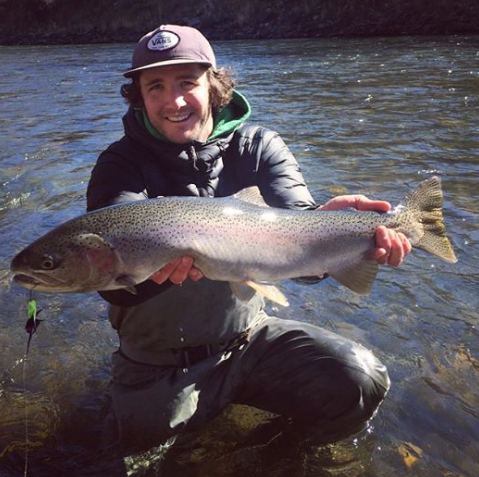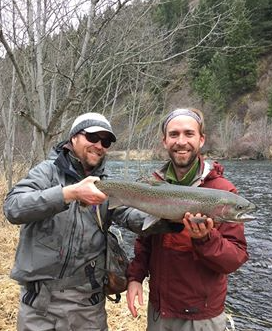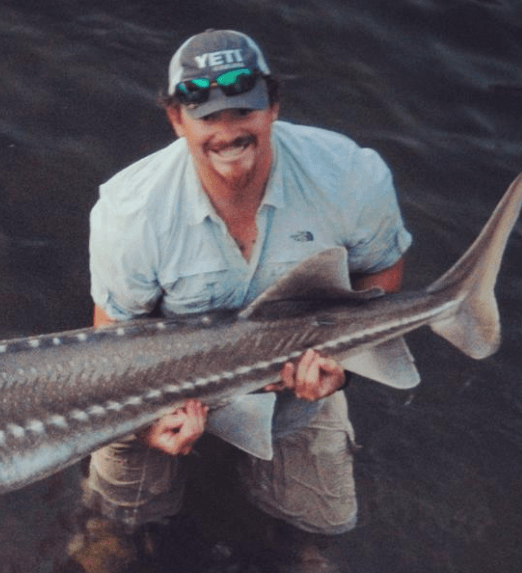How Not To Take a Picture Holding a Fish
Key Takeaways
- Perfecting the fish photo takes practice — Instead of the usual “grip and grin,” try a natural “frown and cradle” pose to avoid awkward or unrealistic fish pictures.
- Positioning matters for great fishing shots — Hold the fish outward, angle it toward the camera, and make sure light hits both your face and the fish evenly for that magazine-worthy moment.
- Capture the story, not just the catch — Include the setting, water reflections, or your fishing partner to give the photo context and showcase the full fishing experience.
- Respect the fish and environment — Minimize time the fish is out of water and handle it gently to ensure safe release while still getting a memorable shot.
- Documenting fish tags can be fascinating — Reporting tag data, like those from ODFW, helps track fish migration and supports conservation efforts across Oregon rivers.
- Guided trips enhance your results — Fishing with experienced guides like those from Winding Waters River Expeditions boosts your chances of landing (and photographing) that perfect steelhead.
The ‘frown and cradle’ is my go-to method for taking a picture while holding a fish. This isn’t in protest of the usual ‘grip and grin,’ I’m just not any good at displaying fish for a camera. Or being in pictures at all, really. My 4th grade school photo was just a stick figure drawing the photographer substituted because he said he couldn’t bear to print the real thing. Yee-ouch.
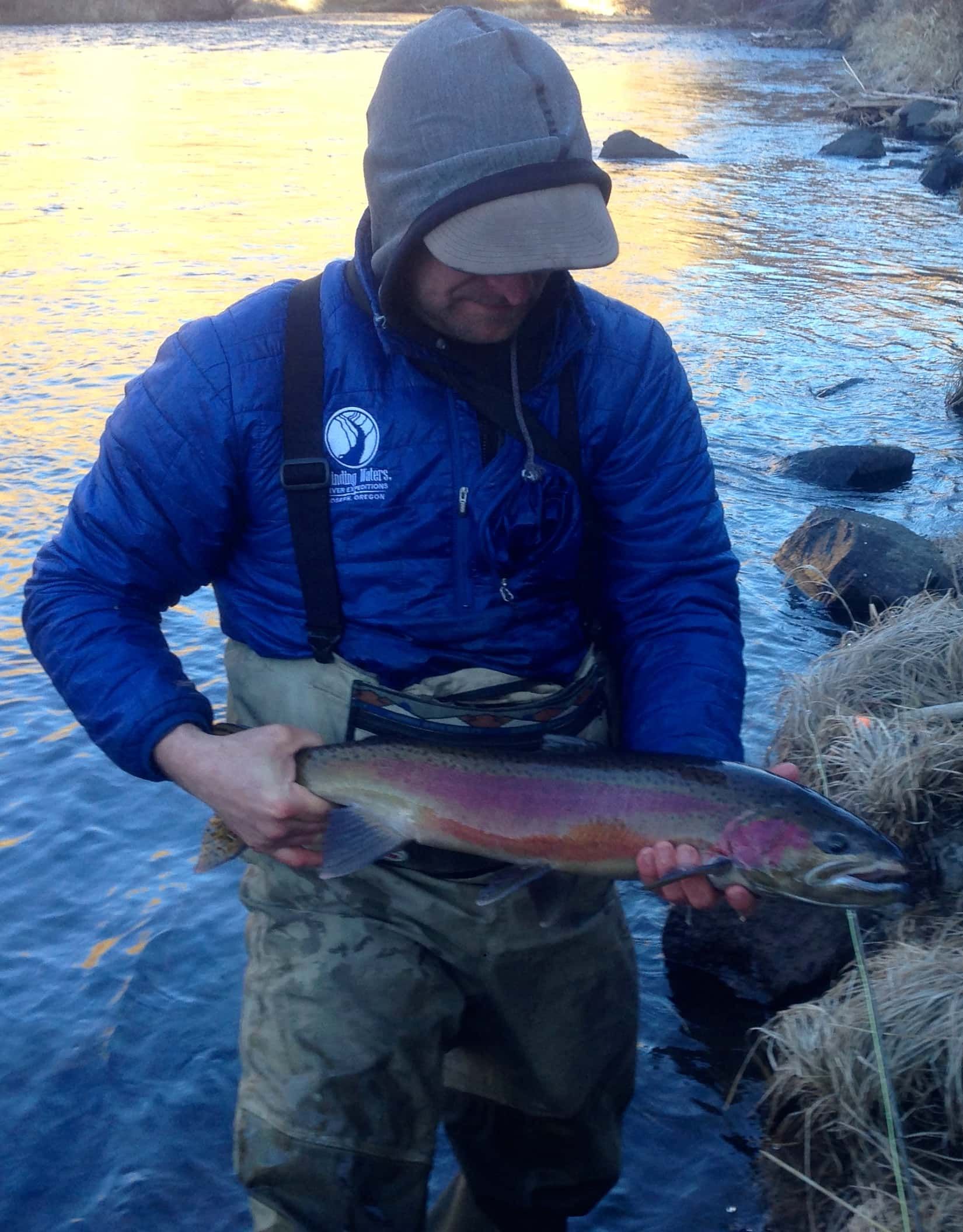
The fish shot seems like it can almost take longer to stage than it does to land a fish. Folks who have the method down come at you with, “Hold it out.” “No, away from you.” “Now turn it.” “Towards me.” “Not that way.” “More to the right.” “Not that much.” “What is wrong with you?”
It’s nice to have the visual memento of the fish you just caught and all, but I don’t know. Just look at this nonsense here, taken a few days ago. There were other photos where I was actually looking up, but they were even worse somehow. This is no reflection on photographer Justin Jones, by the way. He did the best with what he had to work with. He also waded across to help land this specimen, which was awfully nice considering the thorn bushes and boobytraps along this particular section of bank. Thanks, Doctor Jones. These fish are legendary in the Snake River in Hells Canyon too, here’s a super-exciting photo of me looking down at a steelhead and not holding it out to maximize the visual experience like you’re supposed to, so it looks like the fish is about to attack you through the screen all Jaws 3-D IMAX Hi-Def Dolby Surround style.
By way of comparison, here we have proper fish displaying technique as demonstrated by Matt Seitz, shown here lifting weights in a river recently. Notice the glistening water drops, dappled sunlight and a certain joie de vivre in this composition. Nicely done, Matt. And Ansel Adams Jr., or whoever took this shot. Seitz is Idaho-based. Married to Caitlin Baird, daughter of Winding Waters guide Mike Baird. Check out his custom flyrod biz Clearwater Fly Rods on the facebooks. Clearwater rods are apparently built with blanks made of magic wands, based on this and many other pictures of Clearwater rods landing fish that resemble something you’d see served in the Hogwarts banquet hall.
Another guy with plenty of practice holding fish out of the water is WWRE guide Cam Scott. Pike Place Fish Market calls him to consult on advanced techniques. Cam Scott was born with nets for hands. Most of us get dirt under our finernails when we work, Cam Scott has scales under his nails. Cam Scott is so accustomed to holding steelhead with his bare hands, he doesn’t need gloves to weld. That last one doesn’t make a ton of sense, so I’ll quit. Here’s Cam, on the left, executing the double-lindy two-person fish holding pose. Known to very few who are able to endure months of training in a Himalayan flyfishing monastery.
Taking a good fishing photo is another matter entirely. Luckily, I’m also bad at that so can guide you with some authority on what not to do. Remember Justin Jones? He, Jeff Yanke, Paul Arentsen and I found ourselves in hot pursuit of Wallowa County steelhead among scenery I hesitate to call ‘breathtaking,’ because that term gets overused and thrown around a lot. But, seriously, you need an inhaler on hand just to look at these surroundings. Paper bag to blow into and out of at minimum. So here’s Jones, in both pictures, taken seconds apart. You can’t really see him at all in the first photo, because I’m a bad photographer. If you look closely at the next one, you can sort of make him out, casting from atop a big rock. I probably could have gotten closer or changed a setting or whatever. But the important thing here is that I was mainly concerned with getting down the trail to the next piece of water to get my own flies in the water. Anyway, innovative casting platform award goes to Justin Jones.
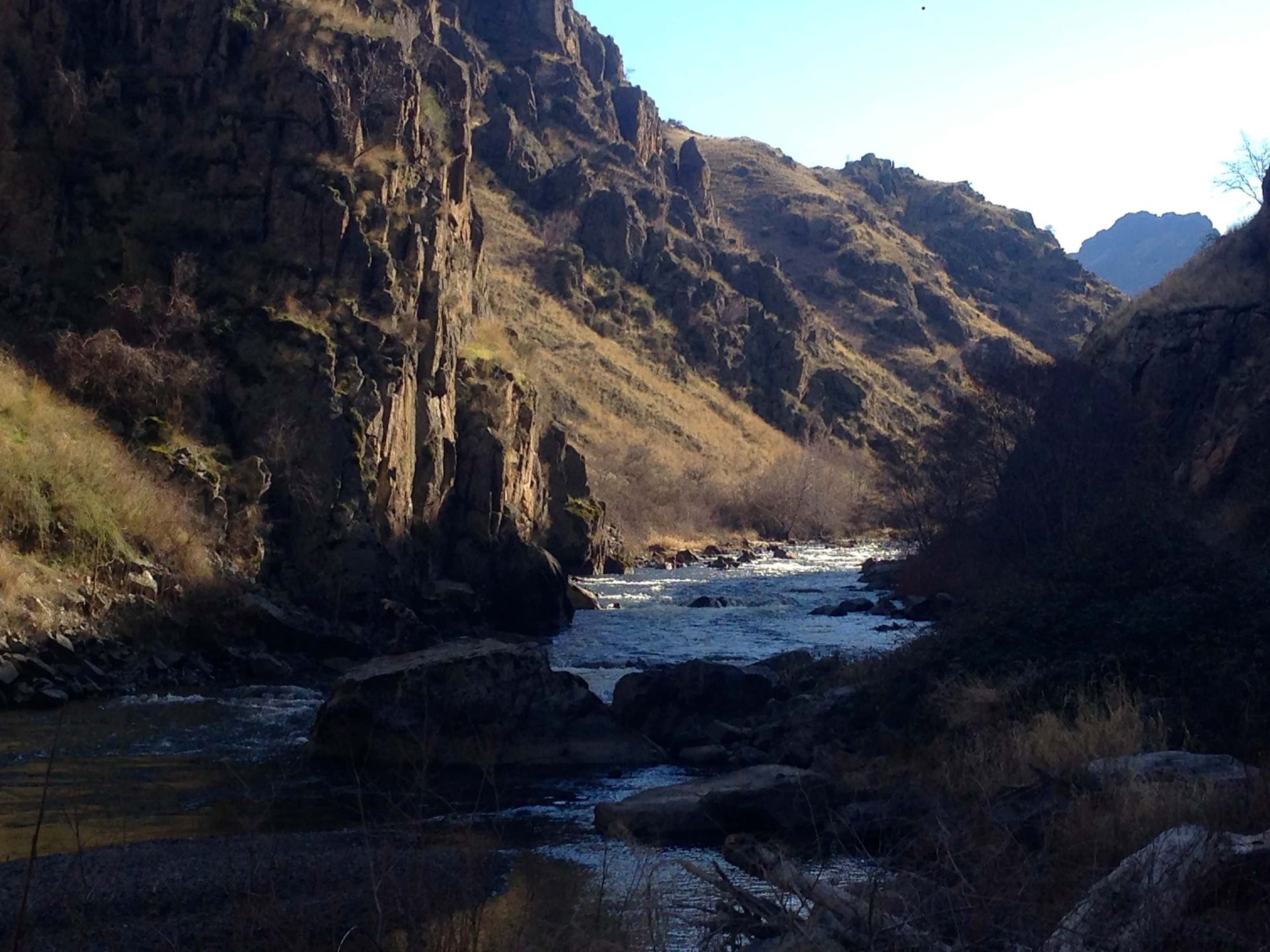
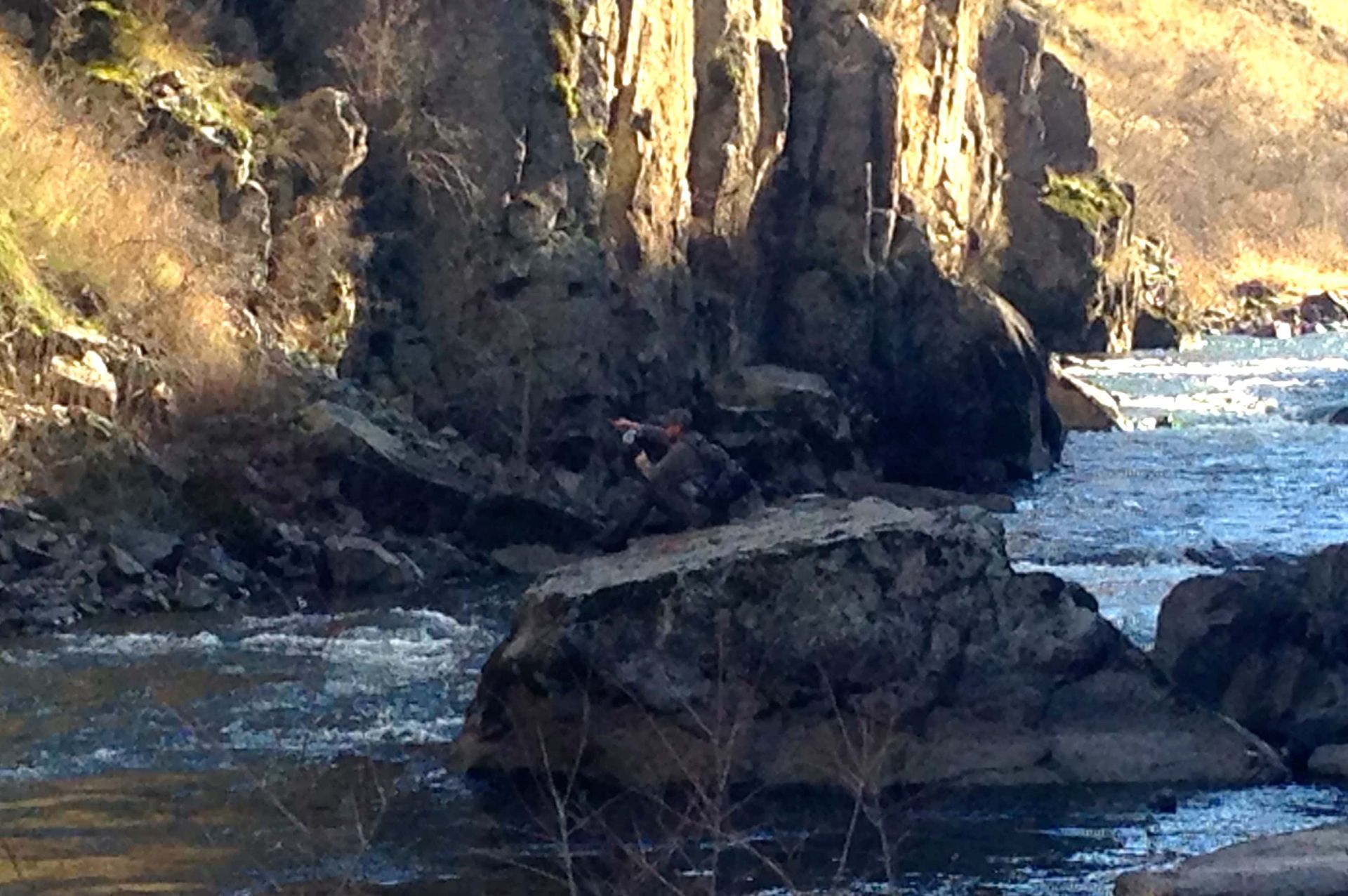
That next piece of water did come through for me, I’m delighted to report. A few things about this fish. We’d been picking up some whitefish, bull trout and rainbows that day. Mike Baird landed a submarine-class whitefish in the morning. So this hookup felt solid, then not much happened. Not a lot of resistance. I thought probably I’d hooked up with a whitey again. It kind of doodled around the stream, no particular place to be, la-dee-dah. I applied pressure and it sort of came along. Doot-dee-doo. And I think we had a classic case of the fish not being all that aware it was hooked. In any case, proximity to the bank woke this fella up and we had ourselves a wrestling match in the final round.
Thing two about this fish, which I didn’t notice until pretty much going to take this picture, is the orange tag there behind the dorsal fin.
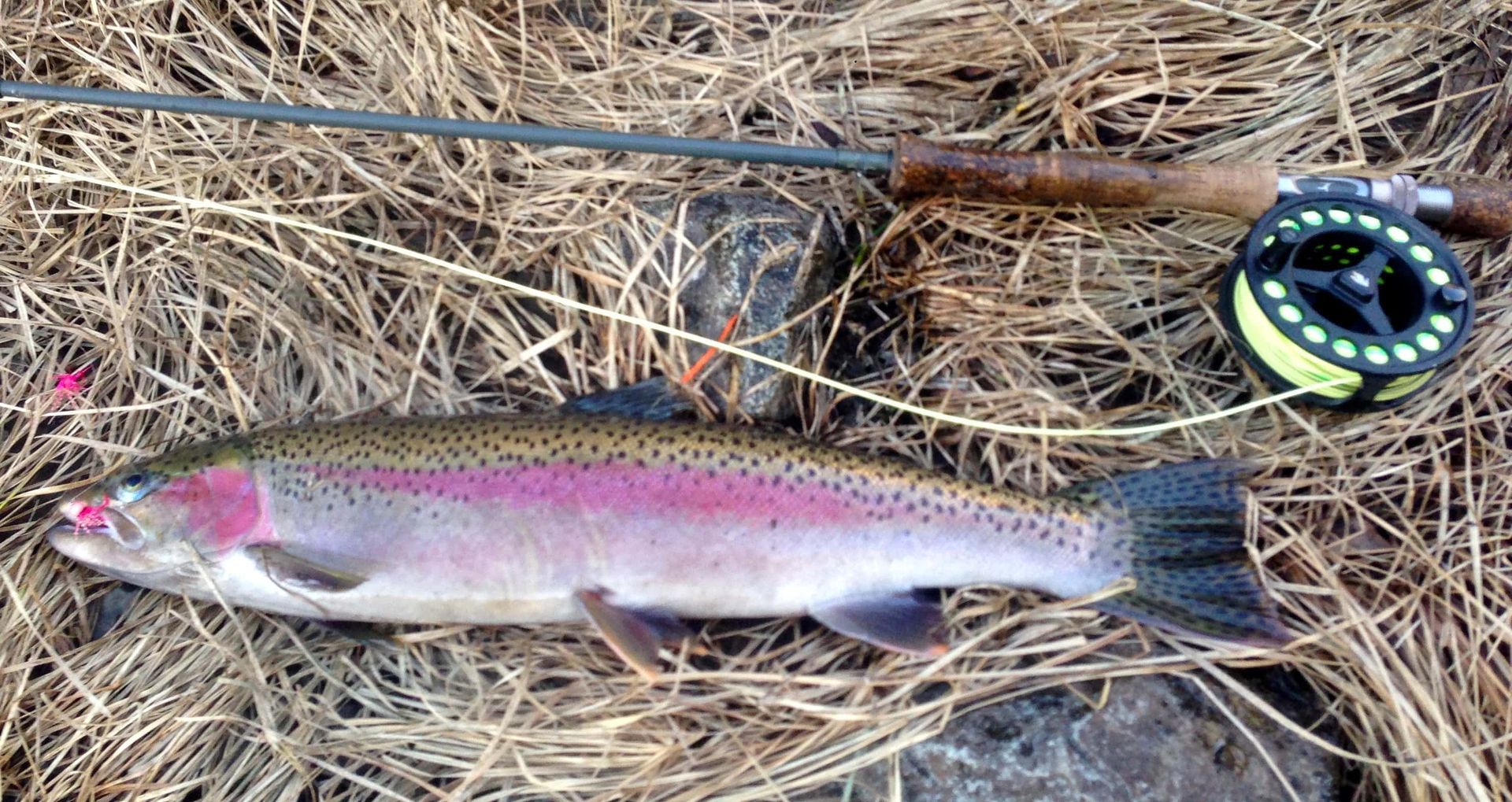
Zoom in, please.
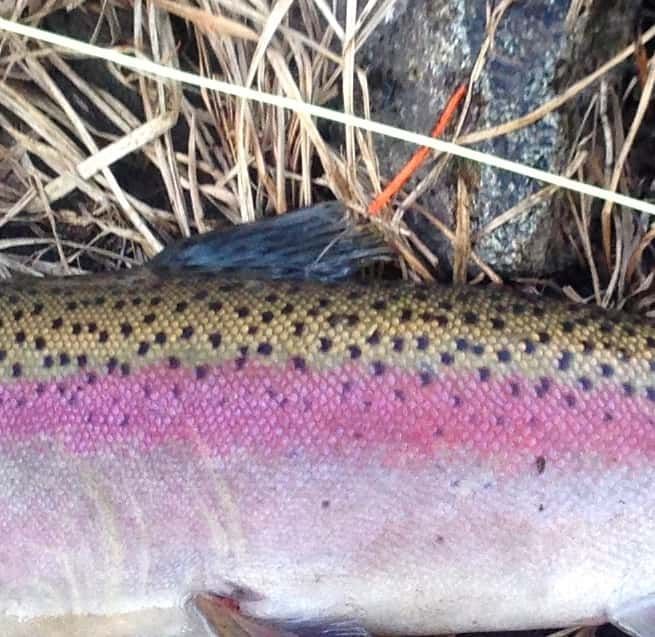
Yes, that’s better. It said, “ODFW The Dalles” Then a bunch of numbers. It sure is nice fishing with Jeff Yanke. Except when you learn he landed three steelhead in three consecutive casts , as happened that day. Allow me to dwell on that for a minute. This guy placed his flies in the river three times. And each time a fish came out on the end. Bing, bing, bing. Just like that. Using the Pythagorean Theorem and postulating the known quantity that steelhead are ‘the fish of a thousand casts,’ if we divide by crazy and carry the what-the-deuce, Jeff must be tying flies using unicorn mane, phoenix hurl and leprechaun sideburns. I mean, three for three? C’mon.
But anway, one of the nice things about fishing with Jeff Yanke is he’s the district biologist for ODFW out here and can hook you up with the data. Well, I’m sure any ODFW office will be happy to supply data but it’s much easier to just hand the tag off at the truck. So this tag turns out to have been inserted in this here steelhead back in October of 2014, up the Deschutes River. It’s preeeeetty cool to find out what these fish got up to on their journeys.
Last week I found a PIT tag transmitter in another steelhead and took it in for Jeff to scan. That steelhead first got on the radar April 30 of 2013 at Little Goose Dam. Next showed up July of 2014 at Bonneville, heading upstream, so it must have hitched a ride down the Columbia for its ocean cruise. Got back to the Imnaha February 11, 2015. I caught it February 24, 2015.
The following day, a mixture of kosher salt, brown sugar, shoyu sauce, home-squeezed apple cider, molasses, cracked pepper and other things was prepared. A Little Chief smoker was plugged in and ran February 26th. On March 2nd of 2015, the results were blended with low-fat cream cheese, or ‘Neufchatel’ — which is Esperanto for ‘low-fat cream cheese’ — sour cream, lemon juice, horseradish, finely minced sweet onion, red pepper, diced green onion, sprinkled with paprika and served at a potluck with little discs of baguette. Delicious. Amazing what these PIT tags can tell you. Simply amazing.
OK, gang. Get out there and get catching because it’s green light go on Wallowa and Grande Ronde river steelheading right now. For help taking fish pictures, and catching the steelhead to take the pictures with, get on the horn for 1/2, full or multi-day guided trips with the crack squad of Winding Waters flyfish guides, Cam Scott and James ‘The Fish Take Pictures of Me’ Nash, pictured here below holding a 29″ steelhead you can’t see because it’s inside that sturgeon. This guy takes finding fish to entirely new levels. This link will get you where you need to be.
Frequently Asked Questions
This article humorously explores the art (and awkwardness) of taking fishing photos — especially how
not to hold a fish for the camera — while sharing a few steelhead fishing adventures and lessons along the way.
What is the best way to hold a fish for a photo?
Hold the fish horizontally, support its belly, and keep it close to the water. Extend it slightly toward the camera without overdoing it. Make sure your hands are wet to protect the fish’s slime layer and always handle it gently to ensure safe release.
Why do anglers hold fish out toward the camera?
Holding the fish out slightly exaggerates its size due to perspective. It’s a popular trick in fishing photography — the closer the fish is to the lens, the bigger it appears. Done right, it creates a dynamic, eye-catching shot that shows off both angler and catch.
What are common mistakes when taking fish photos?
Common mistakes include holding the fish too far from the camera, blocking your face, poor lighting, and awkward poses. Rushing the photo or mishandling the fish can also lead to bad shots — or worse, harm to the fish. Take a second to frame it properly and handle the fish safely.
How can I make my fishing photos look more natural?
Relax your expression, angle your body slightly, and keep your eyes on the fish. Natural lighting helps, so shoot in soft morning or evening light. Avoid forced smiles or stiff poses — the best fishing shots capture genuine excitement and respect for the catch.
What is the “frown and cradle” method?
The “frown and cradle” is a tongue-in-cheek reference to awkwardly holding a fish while looking serious — a contrast to the traditional “grip and grin” pose. It’s a self-deprecating way to poke fun at less-than-perfect fish photos, emphasizing authenticity over showmanship.
What is a “grip and grin” photo?
A “grip and grin” is the classic pose where an angler holds the fish out proudly and smiles for the camera. It’s a staple in fishing photography but can look forced if overdone. The key is to balance enthusiasm with good fish-handling practices and a natural pose.
How should you photograph a fish safely before releasing it?
Keep the fish in the water until the camera is ready, use wet hands, and minimize air exposure — ideally under 10 seconds. Support it horizontally and avoid squeezing. If possible, take the photo near the water so the fish can be quickly and safely released.
Why do some fish have tags on them?
Tags are used by fisheries biologists to track fish migration, growth, and survival. When anglers catch a tagged fish, they can report the tag number to agencies like the Oregon Department of Fish and Wildlife (ODFW) to contribute valuable data to conservation efforts.
How can I improve my fishing photography skills?
Practice framing your shots before landing a fish. Use natural light, focus on the fish’s eye, and capture water droplets or sunlight reflections for depth. Study good examples — like those from guides or experienced anglers — to learn how positioning and timing make the shot.
The post How Not To Take a Picture Holding a Fish appeared first on Winding Waters River Expeditions.

